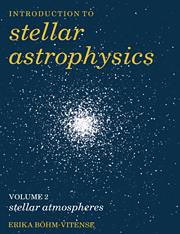Book contents
- Frontmatter
- Contents
- Preface
- 1 Stellar magnitudes and stellar colors
- 2 Stellar spectra
- 3 Temperature estimates for stars
- 4 Basics about radiative transfer
- 5 Radiative transfer in stellar atmospheres
- 6 The depth dependence of the source function
- 7 The continuous absorption coefficient
- 8 The influence of the non-greyness of the absorption coefficient
- 9 The pressure stratification
- 10 Theory of line formation
- 11 The hydrogen lines
- 12 Spectrum analysis
- 13 Basics about non-local thermodynamic equilibrium
- 14 The hydrogen convection zone
- 15 Stellar chromospheres, transition layers, and coronae
- 16 Stellar winds
- Problems
- Appendix LTE model stellar atmospheres
- References
- Index
1 - Stellar magnitudes and stellar colors
Published online by Cambridge University Press: 08 February 2010
- Frontmatter
- Contents
- Preface
- 1 Stellar magnitudes and stellar colors
- 2 Stellar spectra
- 3 Temperature estimates for stars
- 4 Basics about radiative transfer
- 5 Radiative transfer in stellar atmospheres
- 6 The depth dependence of the source function
- 7 The continuous absorption coefficient
- 8 The influence of the non-greyness of the absorption coefficient
- 9 The pressure stratification
- 10 Theory of line formation
- 11 The hydrogen lines
- 12 Spectrum analysis
- 13 Basics about non-local thermodynamic equilibrium
- 14 The hydrogen convection zone
- 15 Stellar chromospheres, transition layers, and coronae
- 16 Stellar winds
- Problems
- Appendix LTE model stellar atmospheres
- References
- Index
Summary
The apparent magnitudes
The easiest quantity to measure for a star is its brightness. It can be measured either by intercomparison of the brightness of different stars or by a quantitative measurement of the energy received on Earth. For a bright enough star – the sun, for instance – the latter could be done in a fundamental but not very accurate way by having the sun shine on a well-insulated bowl of water for a certain length of time and then measuring the increase in temperature. Knowing how much water is in the bowl and knowing the surface area of the water, we can calculate the amount of heat energy received from the sun per cm2 s. The amount received will, of course, depend on the direction of the light beam from the sun with respect to the plane of the water surface (see Fig. 1.1). If the angle between the normal to the water surface and the direction of the beam is δ (see Fig. 1.1a), then the effective cross-section of the beam t is smaller than the actual surface area of the water by a factor of cos δ. In Fig. 1.1a, the amount of heat energy received per cm2 s will therefore be smaller by this factor than in Fig. 1.1b, where the sunlight falls perpendicularly onto the bowl of water.
For stars this method in general will not work; we would have to wait too long before we could measure an increase in temperature, and it is very difficult to prevent the water surface from cooling again in the meantime. We need much more sensitive instruments to measure radiation.
- Type
- Chapter
- Information
- Introduction to Stellar Astrophysics , pp. 1 - 14Publisher: Cambridge University PressPrint publication year: 1989
- 1
- Cited by



